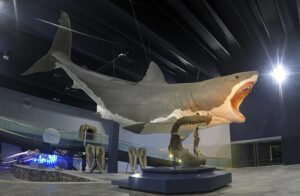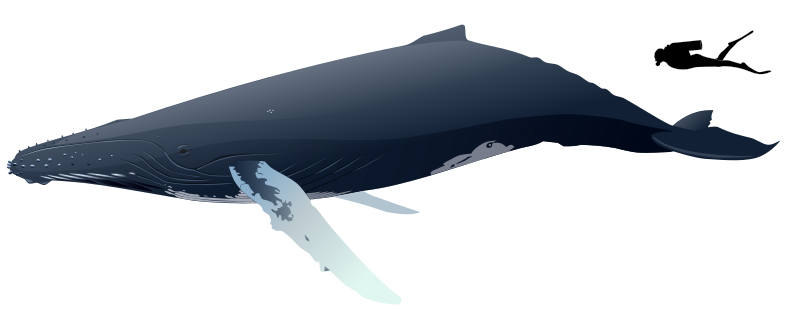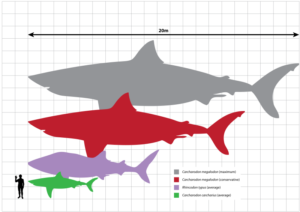Megalodon, or Meg, was one of the most fascinating creatures that ever lived. They are still a mystery, despite being a fossil. Comparing them to modern-day humpback whales would be fascinating.
The Meg was the world’s largest shark, and humpback whales are counted among the larger baleen whales. Both these creatures are unquestionably humongous, meaning they are larger than life. However, they differ in several ways; the most notable is their diet.
So, what if the Meg still existed today, and the ocean witnessed a battle between it and a humpback whale one fine day? Who do you think would have won if the fight had taken place? It’s difficult to imagine. So, in this post, we’ve looked at various factors to see which creature will emerge as the true victor of the battle.
This post is not intended to propose any scientific explanations but rather to provide readers with detailed information to enhance their knowledge. So, without further ado, welcome to the fascinating world of Megalodon vs. Humpback Whale.
Megalodon vs. Humpback Whale: Basic Information
Before we get into the real fight, let us just glance at the basic facts related to both these creatures. It will help us create a basic understanding of the Meg and the humpback whale.
| Comparing Parameters | Humpback Whale | Megalodon |
| Scientific name | Megaptera novaeangliae | Otodus megalodon |
| Family | Balaenopteridae | Otodontidae |
| Genus | Megaptera | Otodus |
| Distribution | Except for confined seas and parts of the High Arctic, almost every ocean on the planet. | Almost every major marine ecosystem. Europe, Africa, the Americas, and Australia are where the majority of fossils have been discovered. |
| Weight | 36 metric tons | 50-75 tons |
| Length | 39 to 52 feet | Up to 67 feet |
| Swim speed | 5 to 15 km/h when traveling2 to 5.5 km/h when feeding25 km/h when swimming fast | 11 mph |
| Diet | Filter feeders | Whales, sea turtles, etc. |
| Senses | Hearing- Low-frequency sounds Sight- Well adapted to see in the depth Taste Touch The sixth sense- The variations in earth’s magnetic field | Smell Good (low-light) vision Ampullae of Lorenzini Hearing |
| Vocalization | Yes | No |
| Bite force | They do not bite or chew | 40000 psi |
| Danger to humans | Not likely | Thought to be aggressive towards humans if were alive. |
| Lifespan (average) | 45-50 years | Maybe up to 150 years |


The Meg: Myth or Real?
Apparently, there is no megalodon today lurking in the depth of our oceans. And this absence often raises the question if the meg was real at all? Or is it just a myth from old folklore?
Megalodon was very much real. These monstrous and predatory great white sharks are assumed to have dominated earth’s oceans 20 million years ago. It was only 3.6 million years ago that they became extinct. These facts are supported by megalodon fossils.
The meg’s 7-inch-long teeth are among the most commonly discovered fossils, hinting at its colossal body size of 60-70 feet. It might also pique your interest to learn that these massive sharks coexisted with dinosaurs.

Ryan Somma (CC BY-SA 2.0) from Wikimedia
Megalodon vs. Humpback whale: Class
Both humpback whales and the meg fall under colossal ocean creatures. However, there is a basic difference between their class. Let’s shed light on that.
Humpback whales are mammals, while the meg was a fish. Scientifically, humpbacks belong to the class of Mammalia, but the meg belonged to Chondrichthyes, a class of cartilaginous fishes.
Verdict: No one is a winner in this context.
Megalodon vs. Humpback whale: The Potential Fight
The most fascinating what if that might be intriguing to our mind is that if the med existed today, would it have involved a fight with humpbacks? What was our chance of witnessing a colossal marine fight?
The meg was huge and highly predatory. The megalodon fossils suggest that this creature fed on whales, among other larger prey, during its time. As a result, a potential fight between the meg and a humpback whale would not be a myth. Baleen whales were also targeted by the megalodon.
Now, it is interesting to explore if there was a fight, who would have won it? What factors would have helped the visitor to dominate the other?
Verdict: A fight would have been a reality if the meg had existed today.
Megalodon vs. Humpback whale: Weight and Size

Several factors differentiate a megalodon from a humpback whale and vice-versa. Out of all those, the physical appearance of both these creatures is worth mentioning.
Both megalodon and humpback whales fall into huge marine creatures, but the former fall under the larger and heavier category. That said, humpback whales weigh 36 metric tons and can grow up to 39 to 52 feet. On the other hand, the meg weighed around 50-75 tons and could grow up to 67 feet.
The meg was so big that it could overshadow the T.Rex. As a result, the meg comes out on top in weight and size. The megalodon’s size would have given it an advantage over a humpback whale.
Verdict: The meg will win with greater weight and a larger size.
Megalodon vs. Humpback whale: Speed
Underwater speed is an essential factor that decides how fast a sea creature can attack its prey or run from its predator. So, let us explore who is faster- the meg or a humpback whale.
The meg had a swimming speed of up to 11 mph, around 17.7 km/h. On the other hand, a humpback whale has a speed of 5 to 15 km/h when traveling and 25 km/h when swimming fast.
The result is pretty clear that in case of a potential fight, the swimming speed of a humpback whale would give it the advantage of swimming faster than the megalodon. So, even if the humpback is in no mood to fight, it can surely escape from an attack.
Verdict: A humpback whale will come out as the winner in terms of swim speed.
Megalodon vs. Humpback whale: Diet
Sharks are highly predatory, and as a result, their diet and hunting style varies greatly from whales. Also, it is worth noting that diet varies among sub-categories of sharks and whales.
The meg was huge and the apex predator. So, its diet undoubtedly included large prey, like whales, sea turtles, seals, fishes, and even smaller sharks. A humpback whale, on the other hand, is a filter feeder. These cetaceans possess baleen plates instead of teeth and feed on plankton, krill, and smaller ocean creatures.
In this context, the most interesting fact is that the meg was known to attack humpback whales during its time. So, if it existed today, it would have no qualms about hunting down and devouring modern-day humpback whales.
Verdict: In a fight, the med would attack and hunt down humpback whales.
Megalodon vs. Humpback whale: Teeth and Bite Power

Most sharks are known to have sharp teeth. But not all whales possess teeth, and they can be divided between baleen and toothed whales.
The meg had teeth that were too long and sharp. As per their fossils, megalodon had 7 inches long teeth and could bite prey with a force of 40000psi. On the contrary, humpback whales are baleen whales, i.e., they do not possess teeth but baleen plates to filter feed.
The megalodon used its long teeth and powerful jaws by ripping through the chest and puncturing its prey’s heart and lungs. As a result, the meg would emerge victoriously in a fight with a humpback whale.
Verdict: The meg would win the fight, leaving the humpback whale mortally wounded.
Megalodon vs. Humpback whale: Fighting Abilities
Every marine creature possesses some kind of fighting ability. However, these abilities vary largely from one species to another. So, let’s explore the fighting abilities of a meg and a humpback.
It is needless to state that the megalodon ruled the food chain during its time. The meg used the technique of leaping upwards and taking a big chomp from its prey. Its long and sharp teeth and massive jaw strength helped enhance its fighting prowess. However, humpbacks are filter feeders and mostly use the bubble net technique to gather a large school of fish at a place to feed on them.
We are not saying that humpback whales do not have any fighting abilities. But many marine experts stress that these huge mammals are peaceful warriors that invest their energy to defend their own kinds and other marine creatures.
As a result, in a fight with a megalodon, a humpback would be a formidable opponent who fights to defend rather than overpower. The humpback whales are the epitome of altruism.
Verdict: The meg would have better-fighting prowess.
Megalodon vs. Humpback whale: Defense
Sharks are great at adapting to different defense systems. This is because they use a combination of their body, teeth, bite force, and senses. Whales also use their teeth, enormous body size, and keen senses.
The meg’s massive size served as its first line of defense against predators. Their powerful bite force, acute senses of smell, vision, and hearing, and the Ampullae of Lorenzini, all helped them attack and eat prey. Humpback whales have massive bodies that most predators avoid attacking. Their swimming speed would also help them defend themselves.
Both the meg and the humpback are equipped with various defensive features. However, the former may earn more brownie points due to its fighting prowess and aggressive behavior.
Verdict: Megalodons would have had a better physical defense system than humpback whales.
Megalodon vs. Humpback whale: Behavior
Whenever we think of sharks, we imagine aggression. However, the same perception is not always associated with the image of a whale.
When it comes to attacking prey, megalodons were infamous for being highly aggressive. Stealthily ambushing the enemies was the technique used by the meg. On the other hand, humpbacks are docile. They mind their own business and do not prefer to display any aggression unless triggered. Humpbacks are filter feeders and prefer to feed on plankton and krill.
The megs were not known to be social, and if they were here in the present marine ecosystem, they would have been the most feared sea creatures.
Verdict: The meg had a better and highly predatory behavior.
Will a Megalodon Hunt Down and Devour a Humpback Whale?
Here, we imagine a potential fight between a megalodon and a humpback whale. Since the former is a fossil, it is fascinating to imagine if it would have hunted down the modern-day humpbacks.
Yes, a megalodon could hunt down a humpback whale in a fight. Megalodons were known to feed on humpback whales during their time. So why wouldn’t they do it now if they did it 3.6 million years ago?
Verdict: Megalodons would have hunted down and fed on humpback whales.
Summary
The final verdict is unmistakable and unequivocal. The former would win in a fight between a megalodon and a humpback whale. Despite the humpbacks’ enormous size, the megs’ fighting prowess, strong bite force, and aggression would have easily enabled them to defeat the gentle giants.

